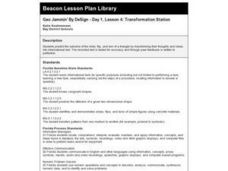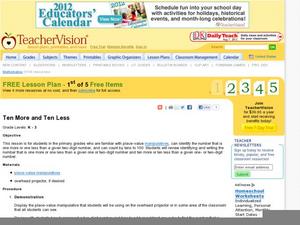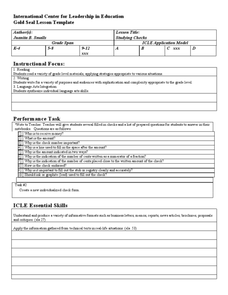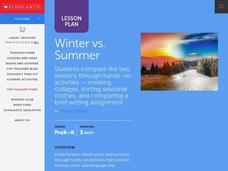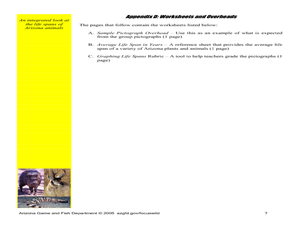Curated OER
Geo Jammin' By DeSign - Day 1, Lesson 4: Transformation Station
Second graders manipulate triangles to discover the concepts of slides, flips and turns of a geometric shape.
Curated OER
Getting Ready to Become An Adult
Students participate in a problem solving activity and discuss how effective their solution was. In this getting ready to become an adult lesson, students read Ta-ne-e-ka and use guiding questions to address the relationships in...
Pennsylvania Department of Education
Freckle Face
Students collect and record data. In this early data analysis lesson, students gather data about their partners face. As a class, the students use tally marks and pictographs to record the data and answer question about the information...
Curated OER
Ten More and Ten Less
Get learners to analyze two-digit numbers based on place value, and use manipulatives to add and subtract both 1 and 10. A place value chart is available, and you can project it during guided practice. Through visualizing...
Curated OER
Studying Checks
While on-line banking and electronic payments seem to be the way of the future, next-generation wage earners still need to understand the details of check writing. Here the focus is on the details of the check including what the...
Curated OER
Winter vs. Summer
Students explore the seasons. In this winter and summer instructional activity, students read The Snowy Day by Ezra Jack Keats and Summer by Maria Ruis. Students compare the 2 seasons as they create t-charts, try on seasonal clothing,...
Curated OER
Managing My Money
Second graders use The Berenstain Bears' to learn about money management. For this money management lesson, 2nd graders read The Berenstain Bears' Dollars and Sense book and complete the 'Rainy Day' worksheet. Students then discuss the...
Curated OER
Savings and Earnings
Fifth graders complete several activities to learn about earning, budgeting, and saving money. In this saving money lesson, 5th graders read a book about saving money and complete a 'Savings and Earnings' worksheet. Students work in...
Curated OER
The Money of Great Britain
Students complete a KWL chart about money including what they would like to learn about the currency of Great Britain. In this British currency lesson, students read a text about this topic and view both American and British pictures of...
Curated OER
Earning an Income
Fourth graders study the role of money in society and define how to earn an income. For this human capital lesson, 4th graders read the book Shoeshine Girl and discuss it. Students discuss various economic concepts and complete the...
Curated OER
Who Needs Numbers?
Young scholars identify whole numbers through the one millions place. In this place value lesson, students read the book The Day Without Math and use place value mats to create numbers to the millions place. Young scholars use base ten...
Curated OER
Count Coins and Bills
Students study the names and values of different denominations of paper money, count sets of money that include both coins and bills. They complete a money chart, read and solve word problems.
Curated OER
Saving and Creating a Personal Budget
Fifth graders brainstorm ways to save money. In this financial awareness lesson, 5th graders read a chapter from the book, From the Mixed-Up Files of Mrs. Basil E. Frankweiler and create a personal budget for themselves.
Curated OER
Savings and Budget
Second graders investigate the concept of developing a budget. In this financial awareness lesson plan, 2nd graders read the book The Case of the Shrunken Allowance and brainstorm ways they can save and budget money. Students create...
Curated OER
Keeping Track of Our Money
Second graders complete activities to learn how to manage money. In this managing money lesson, 2nd graders read the book How the Second Grade Got $8,205.50 to Visit the Statue of Liberty and complete two related worksheets.
Curated OER
Charting Animal Life Spans
Second graders research animal life spans and complete related math activities. In this life span lesson, 2nd graders read How Many Candles and discuss life spans. Students arrange animal cards based on their life spans. Students find...
Charleston School District
Graphing Functions
How do letters and numbers create a picture? Scholars learn to create input/output tables to graph functions. They graph both linear and nonlinear functions by creating tables and plotting points.
EngageNY
Solving Problems by Finding Equivalent Ratios II
Changing ratios make for interesting problems. Pupils solve problems that involve ratios between two quantities that change. Groups use tape diagrams to represent and solve classroom exercises and share their solutions.
EngageNY
Ratios II
Pupils continue the study of ratios by creating ratios from a context. The contexts present more than two quantities, and scholars create contexts that match given ratios.
University of California
Seasons Lab Book
Unlock the mystery behind seasonal change with a collection of worksheets and activities. Whether they are drawing pictures of Earth's orbit around the sun or graphing the temperature and daylight hours of different locations...
Curated OER
All About Me Poster
In this biography/autobiography lesson, students read a few biographies and discuss the term and it's characteristics. Students then brainstorm what makes a good biography/autobiography and create an 'All about me' poster. Suggested...
Curated OER
Savings Planning Using Tables, Line Graphs and Early Proportionality
Students use proportional reasoning to make a chart of daily savings transactions and balances. In this accounting instructional activity, students read word problems and complete three handouts about a bidding and accounting problem....
Curated OER
Mirror, Mirror on the Wall, Who Needs Math in Life at All?
Students think and talk about the ways in which they use math throughout the day. They add each way to a "math in real life" bulletin board and reflect in writing on the ways they use math.
Curated OER
Names Count!
Second graders work in small groups to complete a graph and use data to determine range, mode, and median. They use the number of letters in their names and in fairy tale characters names to produce their data. This is a fun lesson!
